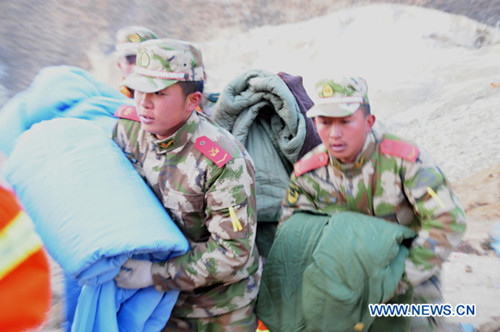
Rescuers work at the accident site after a major landslide hit a mining area of Tibet Huatailong Mining Development Co. Ltd, a subsidiary of the China National Gold Group Corporation, in Maizhokunggar County of Lhasa. (Xinhua)
Rescuers have found one body and are still searching for survivors more than 37 hours after a massive landslide buried 83 miners at a polymetal mine in southwest China's Tibet Autonomous Region.
At about 6 a.m. on Friday, the disaster struck a workers' camp of the Jiama Copper Polymetallic Mine in Maizhokunggar County, about 68 km from Lhasa, the regional capital.
By 8 p.m. Saturday, 3,500 rescuers and 300 large-scale machineries are working on the site, according to local authorities.
"The rescuers are conducting inch-by-inch search but they still cannot locate the missing miners," said Wu Yingjie, deputy secretary of Tibet Autonomous Regional Committee of the Communist Party of China.
He said the miners' survival chances were slim due to the scale of the landslide.
Wu added that a one-meter-wide and 15-meter-long crack was formed at the mountain top, which indicated a possibility of subsequent disasters.
"The two rescue priorities for now are searching for the buried and preventing subsequent disasters," said Wu.
Many rescuers were still digging with their bare hands, as the narrow and damaged local roads had prevented much large-scale machinery from entering, said Xinhua reporters at the site.
Snow started to fall in the area at 1 p.m. on Saturday, which made conditions for the rescue more difficult, they added.
Yang Dongliang, head of the State Administration of Work Safety, said at the site an expert team has been formed to investigate the cause of the landslide.
A spokesman for the regional government said at a press conference that the identities of the 83 buried have been confirmed as rescue work was continuing.
Jiang Li, Vice Minister of Civil Affairs, said the next step of the rescue work is to comfort the families of the victims.
The victims were workers from Tibet Huatailong Mining Development Co. Ltd, a subsidiary of the China National Gold Group Corporation.
Nineteen-year-old He Yuan was among the buried, said Yuan Song, an uncle from his mother's side.
Yuan Song, a native of Xishui County, Guizhou Province, spoke to Xinhua as he waited at an airport in Chongqing Municipality to board a flight to Lhasa as a family representative.
"My sister became too weak to handle this," Yuan said, adding He's father was not able to come due to paralysis caused by a brain haemorrhage.
"My nephew started working when he was 16 years old to pay back the family debt," Yuan said, adding his nephew was believed to have earned about 8,000 yuan (1,288 U.S. dollars) to 9,000 yuan monthly at the mine.
Yuan also had other relatives working in the mine, he said.
According to the government of Zunyi city, which has jurisdiction over the Xishui County, 14 buried workers were from the county.
As the site is at an altitude of more than 4,600 meters, most rescuers have been suffering from slight altitude sickness, according to one member of the group. Further minor landslides have also hampered their efforts. Temperatures as low as minus three degrees Celsius have also affected the sniffer dogs' senses of smell.
The affected area is 3 km wide and 30 meters deep in average, covered with about 2 million cubic meters of mud, rock and debris, a Xinhua reporter said from the disaster site.
As of noon time, more than 300,000 cubic meters of debris had been removed, according to Jiang Yi, an armed police officer engaged in the rescue.
Jiang said there were cracks along nearby mountains. A team consisting of geological experts has been organized to monitor the geological situation.

Copyright ©1999-2011 Chinanews.com. All rights reserved.
Reproduction in whole or in part without permission is prohibited.